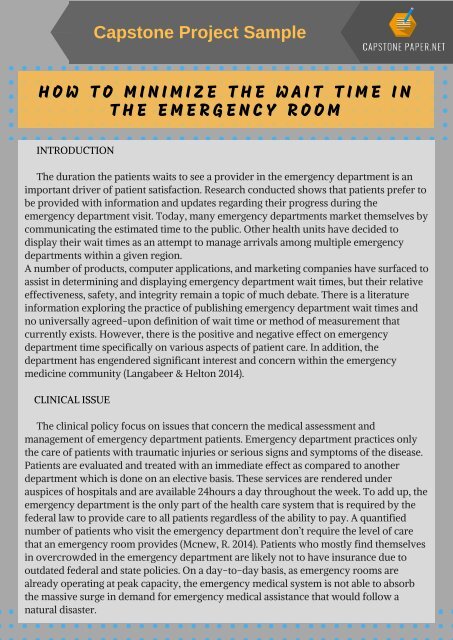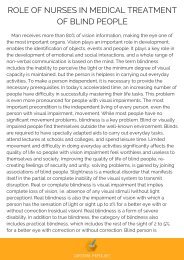Capstone Project Sample
Howdy! Today we've prepared for you a great capstone project sample. For more samples go to https://www.capstonepaper.net/check-out-the-best-capstone-proposal-example/
Howdy! Today we've prepared for you a great capstone project sample. For more samples go to https://www.capstonepaper.net/check-out-the-best-capstone-proposal-example/
You also want an ePaper? Increase the reach of your titles
YUMPU automatically turns print PDFs into web optimized ePapers that Google loves.
<strong>Capstone</strong> <strong>Project</strong> <strong>Sample</strong><br />
H O W T O M I N I M I Z E T H E W A I T T I M E I N<br />
T H E E M E R G E N C Y R O O M<br />
INTRODUCTION<br />
The duration the patients waits to see a provider in the emergency department is an<br />
important driver of patient satisfaction. Research conducted shows that patients prefer to<br />
be provided with information and updates regarding their progress during the<br />
emergency department visit. Today, many emergency departments market themselves by<br />
communicating the estimated time to the public. Other health units have decided to<br />
display their wait times as an attempt to manage arrivals among multiple emergency<br />
departments within a given region.<br />
A number of products, computer applications, and marketing companies have surfaced to<br />
assist in determining and displaying emergency department wait times, but their relative<br />
effectiveness, safety, and integrity remain a topic of much debate. There is a literature<br />
information exploring the practice of publishing emergency department wait times and<br />
no universally agreed-upon definition of wait time or method of measurement that<br />
currently exists. However, there is the positive and negative effect on emergency<br />
department time specifically on various aspects of patient care. In addition, the<br />
department has engendered significant interest and concern within the emergency<br />
medicine community (Langabeer & Helton 2014).<br />
CLINICAL ISSUE<br />
The clinical policy focus on issues that concern the medical assessment and<br />
management of emergency department patients. Emergency department practices only<br />
the care of patients with traumatic injuries or serious signs and symptoms of the disease.<br />
Patients are evaluated and treated with an immediate effect as compared to another<br />
department which is done on an elective basis. These services are rendered under<br />
auspices of hospitals and are available 24hours a day throughout the week. To add up, the<br />
emergency department is the only part of the health care system that is required by the<br />
federal law to provide care to all patients regardless of the ability to pay. A quantified<br />
number of patients who visit the emergency department don’t require the level of care<br />
that an emergency room provides (Mcnew, R. 2014). Patients who mostly find themselves<br />
in overcrowded in the emergency department are likely not to have insurance due to<br />
outdated federal and state policies. On a day-to-day basis, as emergency rooms are<br />
already operating at peak capacity, the emergency medical system is not able to absorb<br />
the massive surge in demand for emergency medical assistance that would follow a<br />
natural disaster.
<strong>Capstone</strong> <strong>Project</strong> <strong>Sample</strong><br />
The following are the issues that face clinic emergency department:<br />
Availability or resources in the clinic. The emergency medical system is stretched<br />
beyond capacity. There are few numbers of hospitals, beds in hospitals, and a<br />
number of the emergency department which leads to overcrowding in the<br />
emergency department.<br />
The clinic does not absorb the surge in demand that would accompany a pandemic,<br />
natural disaster, or terrorist attack due to lack of resources leading patients to wait<br />
in the emergency department.<br />
The number of patients seeking care for non-urgent problems is increasing<br />
tremendously.<br />
The current conditions of emergency department degrade the quality of patient<br />
care. For instance, patients are kept for hours or even days in the emergency rooms<br />
until a hospital bed is available.<br />
Lastly, the current conditions contribute to the uncompensated care burden on<br />
physicians.<br />
IMPORTANCE OF CLINICAL ISSUES<br />
The importance of clinical issues to the health of patient populations are as follows:<br />
Due to lack of medical facilities, emergency medical care is delivered through a<br />
complex hospital system of emergency and delivery. The capacities of these<br />
systems are the main reason for life and death for many patients. This negative<br />
aspect is stretching the clinical emergency department to capacity leaving the little<br />
room to accommodate large surge from such disaster i.e. the viral pandemic.<br />
On matters concerning national disaster, public officials have realized why the<br />
emergency section needs to prepare for and manage unexpected and catastrophic<br />
events. However, the magnitude and scope are inherently difficult to anticipate<br />
such as terrorist attack.<br />
Uncompensated care i.e. aftermath of the calamity, many patients will not be able<br />
to pay for medical services. Therefore, this means must be provided so that to<br />
compensate service providers for disaster care.<br />
There is misaligned incentives in the emergency medical services as well as<br />
hospitals based emergency department. Many clinics have evolved without an<br />
overall policy plan and this has placed hospital emergency department in a<br />
difficult position of serving a community. Most hospitals in the state tend to<br />
provide care only to the poor and indigent those without family members to care<br />
for them (Maville & Huerta, 2013).
<strong>Capstone</strong> <strong>Project</strong> <strong>Sample</strong><br />
R E F E R E N C E S<br />
In Cruz-Cunha, M. M., In Miranda, I. M., & In Goncalves, P. (2013).<br />
Handbook of research on ICTs and management systems for improving<br />
efficiency in healthcare and social care.<br />
In Hall, R. W. (2013). Patient flow: Reducing delay in healthcare delivery.<br />
New York: Springer.<br />
Kellnhauser, E. (2003). Fachenglisch für Pflegekräfte: Die Nutzung<br />
englischer Fachtermini am Beispiel der Pflege in den USA. Hannover: Schlü<br />
ter.<br />
Kussin, S. Z. (2012). Doctor, your patient will see you now: Gaining the<br />
upper hand in your medical care. Lanham, Md: Rowman & Littlefield<br />
Publishers.<br />
Langabeer, J. R. (2007). Health care operations management: A quantitative<br />
approach to business and logistics. Sudbury, Mass: Jones and Bartlett<br />
Publishers.<br />
Langabeer, J. R., & Helton, J. (2014). Health care operations management: A<br />
systems perspective.<br />
Maville, J. A., & Huerta, C. G. (2013). Health promotion in nursing. Clifton<br />
Park, NY: Delmar, Cengage Learning.<br />
Mcnew, R. (2014). Emergency department compliance manual. Place of<br />
publication not identified: Kluwer Law International.


















